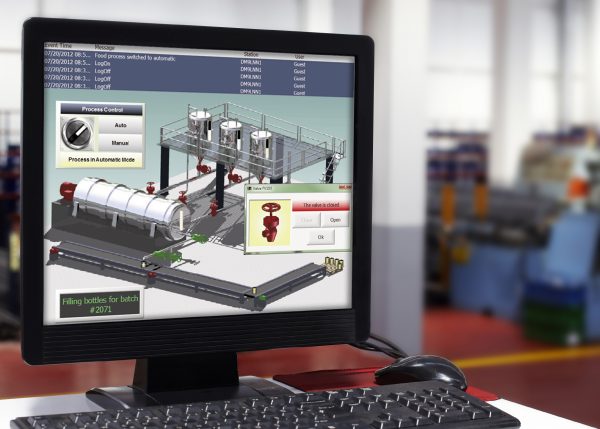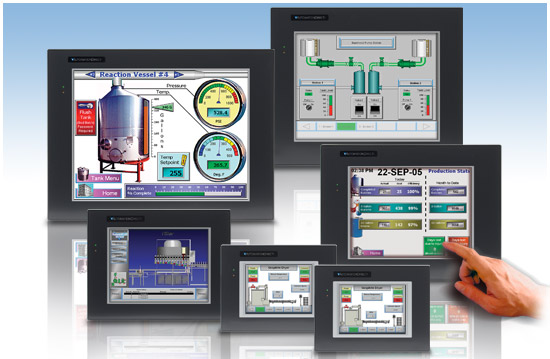There are many ways to irritate an operator working with automated equipment and a bad human-machine interface (HMI) implementation is right up there with the worst of them. Following these guidelines can help you pick the right HMI for your application, keep you on the good side of your operators and engineers, and also help your machines and processes run more smoothly and safely.
Many types of HMIs are available in today’s market from simple operator interface terminals (OITs) with two-line displays to more capable embedded HMI graphics terminals to powerful PC-based HMIs. Here’s how to select the best one for your application.
Pick the Right HMI
When selecting an HMI for a small machine, an OIT is typically acceptable—and certainly simple to configure, easy to use, and low in cost. An OIT will connect directly to the machine controller and provide suitable local operator interface functionality. It is also a good choice when adding additional operator displays to large assembly lines to give operators a better view of equipment status and line operation.
 With larger machines or complex manufacturing lines, more extensive capabilities may be required, and this is where PC-based HMIs can be the best choice. With these types of HMIs, the PC can be industrially hardened for environmental reasons or office-grade. PCs today are available with multiple processors, large hard drives, lots of memory, and include a wide range of built-in connectivity options. High-end functions such as a historian and the ability to simultaneously supervise multiple production processes can quickly justify the extra cost of this option.
With larger machines or complex manufacturing lines, more extensive capabilities may be required, and this is where PC-based HMIs can be the best choice. With these types of HMIs, the PC can be industrially hardened for environmental reasons or office-grade. PCs today are available with multiple processors, large hard drives, lots of memory, and include a wide range of built-in connectivity options. High-end functions such as a historian and the ability to simultaneously supervise multiple production processes can quickly justify the extra cost of this option.
Not Too Big, Not Too Small, Often Just Right
The obvious choice for mid-size equipment and processes is an embedded HMI. However, in many cases, this middle-of-the-road HMI can also fit the bill for applications small to large. Even smaller machines can benefit from connection to the cloud, and these 6- to 15-inch embedded HMIs work well in a variety of configurations whether standalone or networked.
 Embedded HMIs can go it alone, but they also play well with others. In a dedicated, standalone setup, an embedded HMI connected to small or mid-sized automated equipment is a cost-effective and simple solution. Simply ensure the correct protocol is available to talk to the machine controller, hardwire it to the controller with its included cables, and you’re ready to configure the software. Unlike OITs, these embedded HMIs have many features including the capability to interface with mobile devices such as smartphones and tablets. If you’re working in a networked setup, there are two main network architecture options.
Embedded HMIs can go it alone, but they also play well with others. In a dedicated, standalone setup, an embedded HMI connected to small or mid-sized automated equipment is a cost-effective and simple solution. Simply ensure the correct protocol is available to talk to the machine controller, hardwire it to the controller with its included cables, and you’re ready to configure the software. Unlike OITs, these embedded HMIs have many features including the capability to interface with mobile devices such as smartphones and tablets. If you’re working in a networked setup, there are two main network architecture options.
HMI Network Architecture Options
There are two types of networked HMI solutions, one with multiple HMIs connected to one controller, and the other with one HMI connected to multiple controllers. Some applications work best with both options employed simultaneously as multiple HMIs are connected to multiple controllers.
OITs and embedded HMIs fit well into the first scenario, where multiple HMIs are connected to one controller on a single large item of equipment like a printing press, or an assembly line with multiple manual and automated work cells. In either configuration, this networked solution will support many HMIs. If one HMI fails, other HMIs can provide redundant operator interface to minimize downtime. The fall-back HMI may be in a less than optimal location, but it can provide needed functionality until repairs are made.
In the second scenario, where one HMI is connected to multiple controllers, a PC-based HMI is typically the focal point as it can connect to many controllers simultaneously, even using different protocols if necessary. A PC-based HMI can contain many screens, limited only by the designer’s imagination and available memory, so each controller can have its own set of displays. With this option, OITs and/or embedded HMIs are often used to provide local operator interface, with the PC providing an overall view of operation.
Location, Location, Location
A big consideration is where and how to position the HMIs. It is very important to consider ergonomic and normal operator position. If the operator has a kink in his neck from looking at an awkwardly positioned HMI screen, he or she may start to ignore the screens and follow gut instinct. In general, each HMI should be positioned so the operator doesn’t need to look up much, and down just a little.
Speaking of location, it’s important to consider where the operator is going to spend most of his or her time. How far will the operator have to walk to view the HMI? HMIs are often mounted in the main control enclosure, often located at the front end of the production line. But if there are locations where there tend to be line disruptions or stoppages, how much time would be saved if the HMI were mounted close to where these problems typically occur?
 In order to maximize efficiency, it is good practice to mount the main HMI in a centralized and easily accessible location to keep the operator’s steps to a minimum. Fewer steps combined with additional OITs and/or embedded HMIs at strategic problem points can quickly pay for themselves in terms of improved operations and safety.
In order to maximize efficiency, it is good practice to mount the main HMI in a centralized and easily accessible location to keep the operator’s steps to a minimum. Fewer steps combined with additional OITs and/or embedded HMIs at strategic problem points can quickly pay for themselves in terms of improved operations and safety.
Another location consideration is how far the HMI will be from the actual equipment area of interest. Being 20 feet away from the tooling station you are trying to operate manually from the HMI is never an enjoyable experience. Consider mounting the HMI on a swing arm if the machine footprint allows, as this will make the viewing experience up close and personal.
There are many considerations when designing and integrating a control system’s OITs and HMIs, with some of the leading factors discussed here. Once the type of HMI is selected and communication features and functionality are confirmed, consider how the operator and manufacturing engineer will use the OITs and HMIs. Make sure they are readily accessible, and remember that with OITs and HMIs, more is often better in terms of improved operations and safety.
By Chip McDaniel, AutomationDirect
Originally Posted: May 21, 2015


